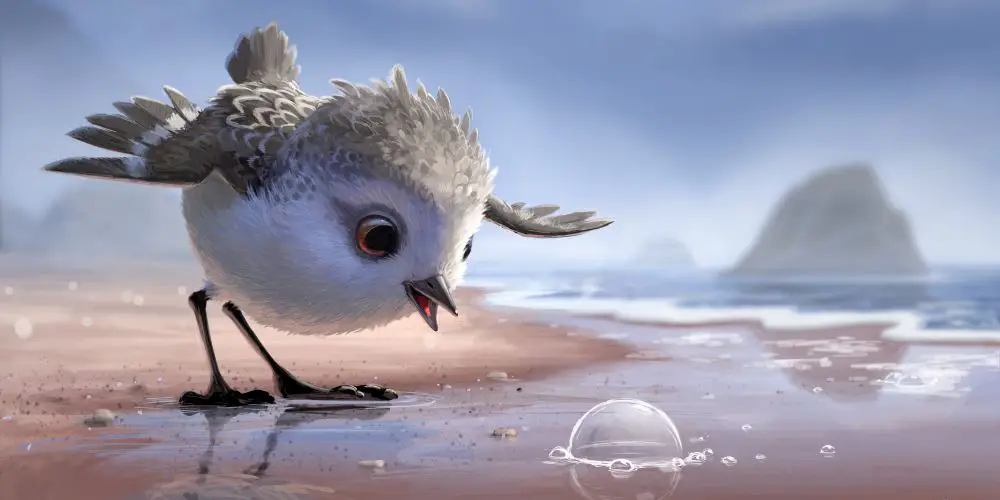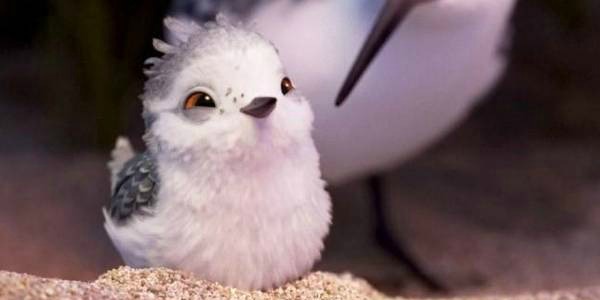Pixar’s PIPER: A Sentimental Kind Of Independence

Ben is a former student of cognitive science who is…
To accompany Pixar’s latest underwater road movie, Finding Dory, we have a similarly ocean-themed short. Pixar’s Piper started as the brainchild of director Alan Barillaro, and tells the story of a young, diminutive sandpiper learning to gather its own food for the first time.
Barillaro worked as a supervising animator on several past Pixar features. With Piper in mind, his work on WALL-E and Brave seems especially notable, considering Piper’s lack of dialogue and highly detailed photorealistic animation – traits that it shares with those two features.
You can watch a short clip of Piper here.
The World Through Small Eyes
The first thing you’ll notice – after the vividness of the setting and the almost overwhelmingly cute character design – is that Piper is mostly in shallow focus. When it isn’t, it’s often because we’re seeing from the titular character’s own perspective. From this we get a sense for Piper’s size, and the size of the world relative to her: she’s absolutely tiny, and she’s facing off with something large and intimidating. Piper’s mother, meanwhile, is too large for the frame, her head shifting in and out of view as she moves up and down.

Piper’s mother is also the only other bird we can see clearly. We can see more sandpipers in the background, but they’re out of focus. So, the shallow focus not only limits the film’s scale but also has an isolating effect, rendering Piper in her own world that she shares only with her mother; her mother’s goal is to help her widen her perspective beyond this, and when she succeeds, they share the victory.
It’s interesting that Piper portrays independence less as a matter of being able to serve oneself without help, and more as a matter of gaining opportunities for deeper relationships, and exploring a wider and more populous world.
A Sickly Sweet Performance
In Piper, the value of photorealistic animation isn’t so much that it approximates reality as it is that it allows for this kind of cinematography to be effective. In fact, one part of the film seems to actively move away from realism: Piper herself.
There are certainly elements of realism to her. The animators took care to accurately reproduce sandpiper behavior and anatomy, and Piper acts with her whole body – no part of her looks static or inanimate. But to an extent, she’s undeniably anthropomorphized. She has distinctly human facial expressions, and conveys emotions like fear and reluctance through purposefully implicative gestures.

On one hand, this means the film has a wide array of tools at its disposal to expose Piper’s inner life, from her face, to her poses, to the pace of her breathing. On the other hand, none of these tools are used with much subtlety; the character acting comes across as cloying rather than truly alive. That said, if there’s one moment when it does shine, it’s when Piper approaches the water for the first time. Then, her spontaneous curiosity comes through well.
To Conclude
Even if Piper’s presence is somewhat saccharine, there’s still some life in her, thanks to the attention to detail the animators exercised when putting her into motion. Moreover, I’d say Pixar’s Piper still effective and worth seeing because of the cinematography, and on the whole it makes a decent case for the expressive potential of photorealistic animation.
Do you find Piper convincing, or does she seem like a caricature to you? Does the character acting affect your opinion of the short?
Piper is currently playing alongside Finding Dory in the U.S., and will be released with that film in the U.K. on July 29th. For Finding Dory‘s international release dates, check here.
Does content like this matter to you?
Become a Member and support film journalism. Unlock access to all of Film Inquiry`s great articles. Join a community of like-minded readers who are passionate about cinema - get access to our private members Network, give back to independent filmmakers, and more.
Ben is a former student of cognitive science who is currently trying to improve his writing style and ability to understand and appreciate films containing unfamiliar perspectives. He tries not to hold films to a strict set of criteria, but does believe that strong movies can change your outlook on the world. His favorite films include Whisper of the Heart, Hellzapoppin', Foolish Wives, 42nd Street, and the work of Charlie Chaplin.













